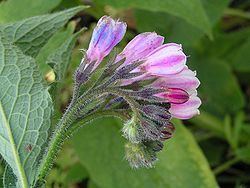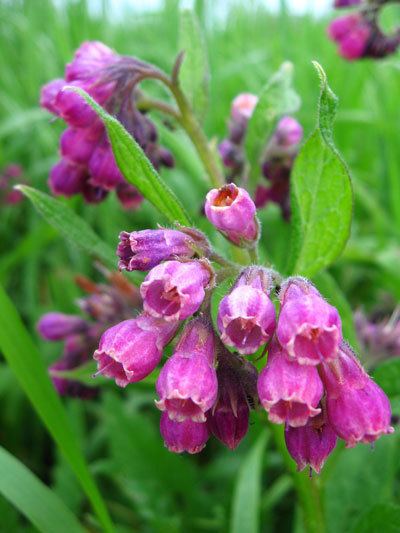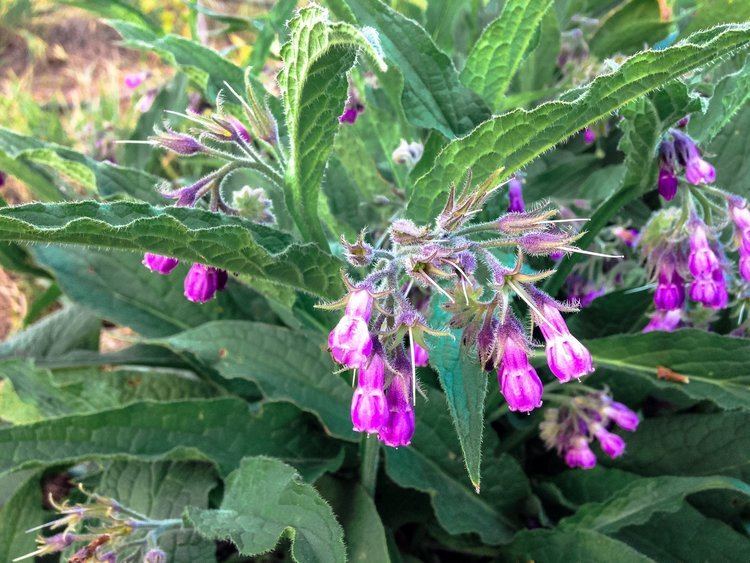Scientific name Symphytum Rank Genus | Higher classification Boraginaceae | |
 | ||
Lower classifications Common comfrey, Symphytum asperum, Symphytum tuberosum, Russian comfrey, Symphytum caucasicum Similar Borage, Yarrow, Field horsetail, Common Nettle, Perforate St John's‑wort | ||
Growing and using comfrey perfect plant for permaculture vegetable gardening
Comfrey (also comphrey) is a common name for plants in the genus Symphytum. Comfrey species are important herbs in organic gardening. It is used as a fertilizer and as an herbal medicine. The most commonly used species is Russian comfrey Symphytum × uplandicum, which is a cross or hybrid of Symphytum officinale (common comfrey) and Symphytum asperum (rough comfrey).
Contents
- Growing and using comfrey perfect plant for permaculture vegetable gardening
- How to grow and use comfrey in your garden
- Description
- Cultivation
- Fertilizer uses
- Propagation
- Medicinal use
- References

How to grow and use comfrey in your garden
Description

Comfrey (Symphytum officinale L.) is a perennial herb of the family Boraginaceae with a black, turnip-like root and large, hairy broad leaves that bears small bell-shaped flowers of various colours, typically cream or purplish, which may be striped. It is native to Europe, growing in damp, grassy places, and is locally frequent throughout Ireland and Britain on river banks and ditches. More common is the hybrid between S. officinale and S. asperum, Symphytum × uplandicum, known as Russian Comfrey, which is widespread in the British Isles, and which interbreeds with S. officinale. Compared to S. officinale, S. × uplandicum is generally more bristly and has flowers which tend to be more blue or violet.
Cultivation

Comfrey has long been recognized by both organic gardeners and herbalists for its great usefulness and versatility; of particular interest is the "Bocking 14" cultivar of Russian Comfrey. This strain was developed during the 1950s by Lawrence D Hills, the founder of the Henry Doubleday Research Association (the organic gardening organisation itself named after the Quaker pioneer who first introduced Russian Comfrey into Britain in the nineteenth century) following trials at Bocking, near Braintree, the original home of the organization.

The comfrey bed should be well prepared by weeding thoroughly, and dressing with manure if available. Offsets should be planted 0.6–1 m (2 ft 0 in–3 ft 3 in) apart with the growing points just below the surface, while root segments should be buried about 5 cm (2.0 in) deep. Keep the bed well watered until the young plants are established. Comfrey should not be harvested in its first season as it needs to become established. Any flowering stems should be removed as these will weaken the plant in its first year.

Comfrey is a fast-growing plant, producing huge amounts of leaf during the growing season, and hence is very nitrogen hungry. Although it is a tenacious grower, it will benefit from the addition of animal manure applied as a mulch, and can also be mulched with other nitrogen rich materials such as lawn clippings, and is one of the few plants that will tolerate the application of fresh urine diluted 50:50 with water, although this should not be regularly added as it may increase salt levels in the soil and have adverse effects on soil life such as worms. Mature comfrey plants can be harvested up to four or five times a year. They are ready for cutting when about 60 cm (24 in) high, and, depending on seasonal conditions, this is usually in mid-Spring. Comfrey will rapidly regrow, and will be ready for further cutting about 5 weeks later. It is said that the best time to cut comfrey is shortly before flowering, for this is when it is at its most potent in terms of the nutrients that it offers. Comfrey can continue growing into mid-autumn, but it is not advisable to continue taking cuttings after early autumn in order to allow the plants to build up winter reserves. After the growing season, leaving comfrey beds fallow may deliver higher yields in future harvests, as the plant builds up energy reserves in its roots.
Comfrey should be harvested by using either shears, a sickle, or a scythe to cut the plant about 2 inches above the ground, taking care handling it because the leaves and stems are covered in hairs that can irritate the skin. It is advisable to wear gloves when handling comfrey. Despite being sterile, Bocking 14 Russian Comfrey will steadily increase in size. It is therefore advisable to split it up every few years. It is however difficult to remove comfrey once established as it is very deep rooting, and any fragments left in the soil will regrow. Rotovation can be successful, but may take several seasons. The best way to eradicate comfrey is to very carefully dig it out, removing as much of the root as possible. This is best done in hot, dry summer weather, wherein the dry conditions will help to kill off any remaining root stumps. Comfrey is generally trouble free once established, although weaker or stressed plants can suffer from comfrey rust or mildew. Both are fungal diseases, although they rarely seriously reduce plant growth and thus do not generally require control. However infected plants should not be used for propagation purposes.
Fertilizer uses
Comfrey is a particularly valuable source of fertility to the organic gardener. It is very deep rooted and acts as a dynamic accumulator, mining a host of nutrients from the soil. These are then made available through its fast-growing leaves (up to 1.8–2.3 kilograms (4.0–5.1 lb) per plant per cut) which, lacking fibres, quickly break down to a thick black liquid. There is also no risk of nitrogen robbery when comfrey is dug into the soil as the C:N ratio of the leaves is lower than that of well-rotted compost. Comfrey is an excellent source of potassium, an essential plant nutrient needed for flower, seed and fruit production. Its leaves contain 2–3 times more potassium than farmyard manure, mined from deep in the subsoil, tapping into reserves that would not normally be available to plants.
There are various ways in which comfrey can be used as a fertilizer. These include:
Propagation
Bocking 14 is sterile, and therefore will not set seed (one of its advantages over other cultivars as it will not spread out of control), thus is propagated from root cuttings. The gardener can produce his or her own "offsets" from mature, strongly growing plants by driving a spade horizontally through the leaf clumps about 7 cm (2.8 in) below the soil surface. This removes the crown, which can then be split into pieces. The original plant will quickly recover, and each piece can be replanted with the growing points just below the soil surface, and will quickly grow into new plants. When choosing plants to divide, ensure that they are strong healthy specimens with no signs of rust or mildew. When dividing comfrey plants, take care not to spread root fragments around, or dispose of on the compost heap, as each can re-root, and comfrey can be a very difficult plant to get rid of. Offsets can also be purchased by mail order from specialist nurseries in order to initially build up a stock of plants.
Medicinal use
Contemporary herbalists have a mixed view of comfrey, despite widespread historical use. Its traditional names of knitbone, boneset and the derivation of its Latin name Symphytum (from the Greek symphis, meaning growing together of bones, and phyton, a plant), speak to its longstanding reputation as a therapeutic herb. Comfrey was historically used to treat a wide variety of ailments ranging from bronchial problems, broken bones, sprains, arthritis, gastric and varicose ulcers, severe burns, acne and other skin conditions. It was reputed to have bone and teeth building properties in children, and have value in treating "many female disorders".
The plant contains the small organic molecule allantoin, which is thought to stimulate cell growth and repair while also depressing inflammation. Constituents of comfrey also include mucilage, steroidal saponins, tannins, pyrrolizidine alkaloids, inulin, and proteins.
In modern herbalism, comfrey is most commonly used topically. Some experts say that comfrey should be restricted to topical use, and should never be ingested, as it contains dangerous amounts of hepatotoxic pyrrolizidine alkaloids (PAs). Studies associating comfrey with veno-occlusive disease (VOD), do not differentiate between Russian and common comfrey, plants with very different levels of PAs. VOD can in turn lead to liver failure, and comfrey has been implicated in at least one death, though the type of comfrey being consumed, and other dietary, physiological and pharmacodynamic factors were not accounted for. In 2001, the United States Food and Drug Administration issued a ban of comfrey products marketed for internal use, and a warning label for those intended for external use. In addition to restrictions on oral use, some experts recommend applying comfrey extracts no longer than 10 days in a row, and no more than 4–6 weeks a year.
